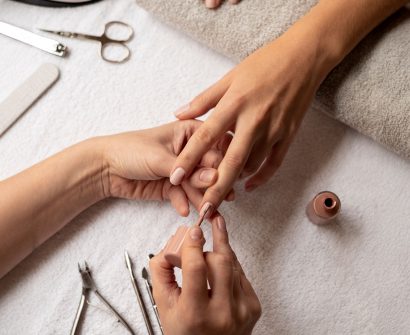
Acrylic nails have been a popular choice for many who want longer, more durable nails without the wait. Whether you’re new to acrylic nails or a seasoned wearer, understanding how long they last and how to care for them can help you make the most of your manicure. In this detailed guide, we’ll cover the lifespan of acrylic nails, factors affecting their longevity, maintenance tips, and answer some frequently asked questions (FAQs).
What Are Acrylic Nails?
Acrylic nails are made by mixing a liquid monomer with a powder polymer to create a malleable paste. This mixture is applied to your natural nails or nail tips, where it hardens and forms a protective, durable shell. Once shaped and dried, acrylic nails can be polished and decorated like natural nails, offering length, strength, and aesthetic versatility.
How Long Do Acrylic Nails Last?
On average, acrylic nails can last 2 to 3 weeks before they need to be refilled or removed. However, with proper care and regular maintenance, they can last even longer—up to 6 to 8 weeks.
The key point to remember is that while the acrylic itself is durable, your natural nails underneath will continue to grow, and this growth will create a gap between the acrylic and your cuticle over time.
Factors That Affect the Longevity of Acrylic Nails
- Nail Growth Rate: If your nails grow quickly, you’ll see a gap between your acrylic nails and cuticles sooner. This doesn’t necessarily mean the acrylic has deteriorated but signals it’s time for a fill-in.
- Lifestyle: People who frequently use their hands for physical activities—such as typing, cleaning, or sports—may find their acrylic nails wear out faster. Handling harsh chemicals or excessive water can also weaken the nails.
- Application Quality: The skill of the nail technician is critical. A professional and experienced technician will ensure that the acrylic is applied evenly, reducing the chances of lifting, cracking, or chipping.
- Proper Care: How you maintain your nails plays a big role in how long they last. Avoid using your nails as tools (e.g., opening cans) and take care when performing tasks that could strain or damage them.
- Nail Condition: If your natural nails are brittle, weak, or damaged, the acrylic may not adhere as well, which could shorten the life of the nails.
Signs That It’s Time for a Fill-In or Removal
- Visible Growth: When you see a gap between your cuticle and the acrylic nail.
- Lifting: If the acrylic starts to lift from your natural nail, it can cause moisture and dirt to get trapped, leading to potential infections.
- Chipping or Cracking: Small cracks or chips in the acrylic can worsen over time, making your nails look uneven or unhealthy.
How to Maintain Acrylic Nails
- Moisturize Your Cuticles: Dry cuticles can cause the acrylic to lift prematurely. Regularly applying cuticle oil keeps your nails healthy.
- Be Gentle: Avoid activities that could put pressure on your acrylics. Always use tools instead of your nails when performing tasks like opening packages.
- Wear Gloves: When doing household chores, especially those involving water or chemicals, wear gloves to protect your acrylics.
- Regular Fills: Scheduling a fill every 2-3 weeks ensures your acrylic nails stay fresh and well-maintained. This also helps prevent lifting and potential damage to your natural nails.
How to Remove Acrylic Nails Properly
It’s important to remove acrylic nails correctly to avoid damage to your natural nails. Here’s a step-by-step guide for safe removal:
- File the Surface: Use a nail file to file the top layer of the acrylic, reducing the thickness.
- Soak in Acetone: Place your nails in a bowl of acetone, or wrap them with acetone-soaked cotton balls, and cover with aluminum foil. Let them soak for 15-20 minutes.
- Gently Remove Acrylic: After soaking, gently push off the acrylic using a cuticle pusher or orange stick. Be careful not to force any acrylic off, as this could damage your natural nails.
- Buff and Moisturize: Once the acrylic is removed, buff your natural nails and apply a nourishing cuticle oil or hand cream to restore moisture.
Frequently Asked Questions (FAQs)
- Can I go longer than 2-3 weeks without a fill?
Technically, yes, but it’s not recommended. The longer you go without a fill, the more visible the gap between your acrylic and natural nails becomes, and the greater the chance of lifting and damage. - How much does a fill cost?
The cost varies depending on location and the skill of the technician, but fills generally range from $20 to $50. - Do acrylic nails damage your natural nails?
When applied and removed correctly, acrylic nails shouldn’t cause significant damage. However, improper removal or overuse can weaken your natural nails. - Can I paint over acrylic nails?
Yes! You can apply regular nail polish over acrylic nails just like you would on your natural nails. You can also use gel polish for a longer-lasting finish. - What should I do if my acrylic nail lifts?
If you notice lifting, it’s best to visit your nail technician as soon as possible. Don’t try to fix it yourself, as this can introduce bacteria and lead to infections. - Can I repair a cracked acrylic nail at home?
It’s possible to repair a small crack by filing down the area and applying nail glue, but visiting a professional is a safer option to ensure the crack doesn’t worsen. - How often should I give my nails a break from acrylics?
It’s a good idea to take a break every few months to allow your natural nails to breathe and recover. During this time, focus on moisturizing and strengthening treatments.
Conclusion
Acrylic nails are a fantastic option for those looking to add length, strength, and style to their natural nails. With proper care and regular maintenance, they can last several weeks, providing a polished look. However, the key to keeping acrylic nails in tip-top shape is consistent upkeep—regular fills, gentle handling, and safe removal.
By following the tips in this guide, you’ll enjoy long-lasting, beautiful acrylic nails without compromising the health of your natural nails!Acrylic nails have been a popular choice for many who want longer, more durable nails without the wait. Whether you’re new to acrylic nails or a seasoned wearer, understanding how long they last and how to care for them can help you make the most of your manicure. In this detailed guide, we’ll cover the lifespan of acrylic nails, factors affecting their longevity, maintenance tips, and answer some frequently asked questions (FAQs).
What Are Acrylic Nails?
Acrylic nails are made by mixing a liquid monomer with a powder polymer to create a malleable paste. This mixture is applied to your natural nails or nail tips, where it hardens and forms a protective, durable shell. Once shaped and dried, acrylic nails can be polished and decorated like natural nails, offering length, strength, and aesthetic versatility.
How Long Do Acrylic Nails Last?
On average, acrylic nails can last 2 to 3 weeks before they need to be refilled or removed. However, with proper care and regular maintenance, they can last even longer—up to 6 to 8 weeks. The key point to remember is that while the acrylic itself is durable, your natural nails underneath will continue to grow, and this growth will create a gap between the acrylic and your cuticle over time.
Factors That Affect the Longevity of Acrylic Nails
- Nail Growth Rate: If your nails grow quickly, you’ll see a gap between your acrylic nails and cuticles sooner. This doesn’t necessarily mean the acrylic has deteriorated but signals it’s time for a fill-in.
- Lifestyle: People who frequently use their hands for physical activities—such as typing, cleaning, or sports—may find their acrylic nails wear out faster. Handling harsh chemicals or excessive water can also weaken the nails.
- Application Quality: The skill of the nail technician is critical. A professional and experienced technician will ensure that the acrylic is applied evenly, reducing the chances of lifting, cracking, or chipping.
- Proper Care: How you maintain your nails plays a big role in how long they last. Avoid using your nails as tools (e.g., opening cans) and take care when performing tasks that could strain or damage them.
- Nail Condition: If your natural nails are brittle, weak, or damaged, the acrylic may not adhere as well, which could shorten the life of the nails.
Signs That It’s Time for a Fill-In or Removal
- Visible Growth: When you see a gap between your cuticle and the acrylic nail.
- Lifting: If the acrylic starts to lift from your natural nail, it can cause moisture and dirt to get trapped, leading to potential infections.
- Chipping or Cracking: Small cracks or chips in the acrylic can worsen over time, making your nails look uneven or unhealthy.
How to Maintain Acrylic Nails
- Moisturize Your Cuticles: Dry cuticles can cause the acrylic to lift prematurely. Regularly applying cuticle oil keeps your nails healthy.
- Be Gentle: Avoid activities that could put pressure on your acrylics. Always use tools instead of your nails when performing tasks like opening packages.
- Wear Gloves: When doing household chores, especially those involving water or chemicals, wear gloves to protect your acrylics.
- Regular Fills: Scheduling a fill every 2-3 weeks ensures your acrylic nails stay fresh and well-maintained. This also helps prevent lifting and potential damage to your natural nails.
How to Remove Acrylic Nails Properly
It’s important to remove acrylic nails correctly to avoid damage to your natural nails. Here’s a step-by-step guide for safe removal:
- File the Surface: Use a nail file to file the top layer of the acrylic, reducing the thickness.
- Soak in Acetone: Place your nails in a bowl of acetone, or wrap them with acetone-soaked cotton balls, and cover with aluminum foil. Let them soak for 15-20 minutes.
- Gently Remove Acrylic: After soaking, gently push off the acrylic using a cuticle pusher or orange stick. Be careful not to force any acrylic off, as this could damage your natural nails.
- Buff and Moisturize: Once the acrylic is removed, buff your natural nails and apply a nourishing cuticle oil or hand cream to restore moisture.
Conclusion
Acrylic nails are a fantastic option for those looking to add length, strength, and style to their natural nails. With proper care and regular maintenance, they can last several weeks, providing a polished look. However, the key to keeping acrylic nails in tip-top shape is consistent upkeep—regular fills, gentle handling, and safe removal. By following the tips in this guide, you’ll enjoy long-lasting, beautiful acrylic nails without compromising the health of your natural nails!



